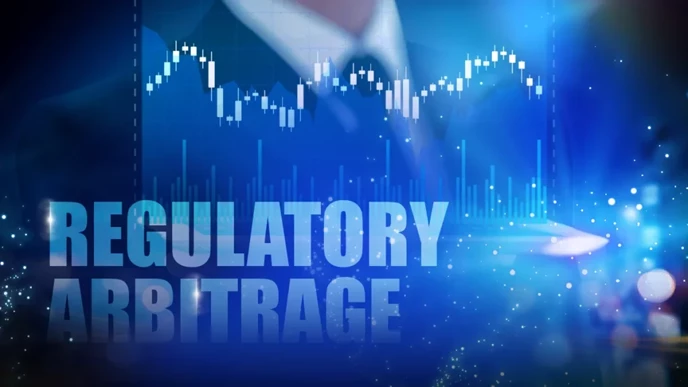What is Regulatory Arbitrage? How Big Players Side-Step Regulation

In April of 2023, CEO of Coinbase Brian Armstrong indicated that he might take the centralized exchange to a different country.
He cited unfavorable crypto regulation and regulatory uncertainty as the reason.
This phenomenon is called Regulatory Arbitrage.
What is Regulatory Arbitrage?
Regulatory arbitrage refers to the practice of taking advantage of differences in regulations or laws in different jurisdictions in order to gain a competitive advantage or reduce costs. This can involve, for example, choosing to do business in a country with less strict regulations or moving operations to a jurisdiction with more favorable tax laws.
If you’ve ever heard of arbitrage in the financial markets, then you can grasp the way it’s done on some scale.
In trading, arbitrage is to buy and sell a financial instrument at the same time in an attempt to generate a profit from the difference. In the corporate world, it’s a bit different.
In a global financial landscape, institutes have latitude in the way that they do business or structure financial transactions, paving the way for savvy players to manipulate the playing field to their advantage. It’s not even illegal, and regulators are well aware that it happens. However, from a moral perspective, regulatory arbitrage pushes the envelope. And while policymakers may not be able to quash it entirely, they maintain that they’re trying to reduce the instances of regulatory arbitrage in the banking system and beyond.
Banks are a major player in regulatory arbitrage. Rather than face the heightened regulatory requirements that were added in response to the Great Financial Crisis, like Dodd-Frank in the U.S., they’ve played dodgeball with the rules.
However, if you think about it, banks have been crying foul for years over the lighter regulation and capital costs that their fintech rivals must follow. So one argument around regulatory arbitrage is that fintechs are doing it, providing the very financial services that banks have been known for without having the same compliance, legal and oversight costs as legacy financial institutions.
The cryptocurrency industry has also been accused of performing regulatory arbitrage. However, the genesis of the cryptocurrency and blockchain industry isn’t to sneak around the rules. The idea is innovation with a decentralized system that is so transparent and self-contained that it abides by its own trustless standards.
Regulatory Arbitrage Mechanics
Depending on the type of company, regulatory arbitrage can take several different forms. Let’s explore some of the ways it’s done.
- M&A: Cross border M&A deals are one way that investment banks have a chance to pick and choose the rules by which they play. This is where the target company, or the one being acquired, is headquartered in a jurisdiction with perhaps weaker regulation. As a result, the banks involved in the deal could potentially avoid the stricter rules in favor of the lighter rules and get by with regulatory arbitrage.
- IPO: Elsewhere in the capital markets, regulatory arbitrage also takes place in the listed markets. In the U.S. market, companies looking to go public that are bound by undesirable tax requirements, such as investment companies, could do some fancy footwork. By restructuring themselves in another way, such as an MLP, to become eligible for more attractive tax rates in their IPO.
- Financial Products: Another way that regulatory arbitrage can work is in the development and sale of financial products. It could be cheaper to build a product in one region than another. It might also be that the risk of regulatory penalties for a risky financial product could be higher in one region vs. another. As a result, a company could decide to develop a financial product in one market but sell it in another market where the potential for profit is higher and the risk of regulatory penalties is lower.
Regulatory Arbitrage Examples
- AIG is an infamous example of regulatory arbitrage. During the height of the financial crisis of 2008, traders in the London subsidiary of the U.S.-based insurance giant participated in some risky transactions. These trades were not within the confines of the American regulatory framework. When those trades went bad, it brought AIG to the doorstep of failure. Ultimately, American taxpayers footed the bill to the tune of $180 billion.
- Silicon Valley Bank (SVB) is the latest U.S. bank to fail, placing customers at risk of severe loss and the banking industry at risk of a contagion effect. While regulators paved the way for SVB to be acquired by HSBC in the 11th hour, there’s still plenty of blame and damage to go around. This scandal brought the Federal Deposit Insurance Corporation’s (FDIC’s) $250,000 guaranteed sum into the spotlight. It showcased how some depositors participated in regulatory arbitrage by spreading their funds over multiple banks.

- Uber offers yet another example of regulatory arbitrage. The ride-share company is famous for classifying its drivers as non-employees, or independent contractors, in the countries where it operates. As a result, it’s not obligated to provide the usual benefits that it would otherwise be required to provide to these workers.
- Facebook participates in its own type of regulatory arbitrage. Data privacy is a major issue for social media platforms, especially global ones. Facebook has been known to tweak its terms and conditions so that it can better control the amount of user data that fall under tight EU privacy regulations.
Conclusion
In reality, a truly global financial system in which there’s harmony across the regulatory landscape is not likely to happen. As a result, companies that want to play by their own rules will be able to find a way to do this through regulatory arbitrage. The finance industry has innovation on its side and therefore will likely be able to outsmart the regulation even as the rules are being rewritten. Companies aren’t going to stop looking for the lowest regulatory cost for transactions, and as long as they do, regulatory arbitrage is probably going to stick around.
Join The Leading Crypto Channel
JOINDisclaimer:Please note that nothing on this website constitutes financial advice. Whilst every effort has been made to ensure that the information provided on this website is accurate, individuals must not rely on this information to make a financial or investment decision. Before making any decision, we strongly recommend you consult a qualified professional who should take into account your specific investment objectives, financial situation and individual needs.

Gerelyn
Gerelyn is a financial journalist who has been covering Wall Street for more than 20 years. After reporting for some of the top trade publications on investment banking, infrastructure and retirement, she was drawn to decentralization and shifted her coverage to the blockchain and cryptocurrency space in mid-2017. Since then, she has contributed to several major Bitcoin, Blockchain, and DeFi news sites, and has also written a children’s book.

Development
Knowledge
Subscribe To Newsletter
Stay up-to-date with all the latest news about
Liquid Loans, Fetch Oracle and more.
Copyright © 2024 Crave Management.
All Rights Reserved.

The LL Librarian
Your Genius Liquid Loans Knowledge Assistant




